Bob Ross Painting Classes in Silt Colorado
>SHOP FOR BOB ROSS ART MATERIALS HERE
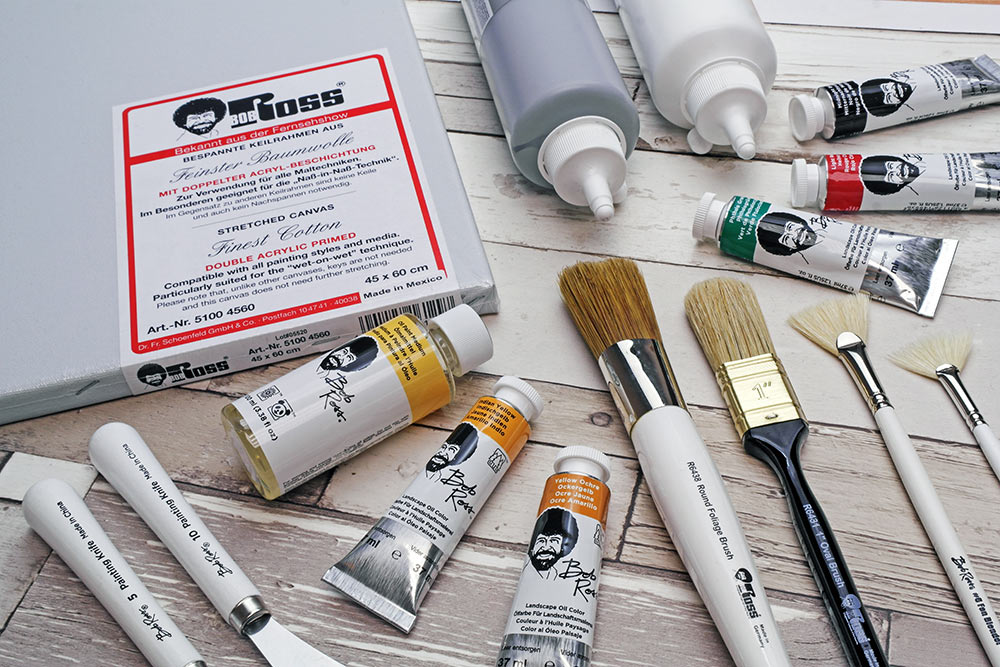
You may have never heard of Bob Ross when he was alive, but now, 25 years after his death, he is becoming a household name. With his affable character, soft voice and his happy little accidents, Bob Ross has become a lock down sensation! People are tuning in and picking up a paint brush – often for the first time! Read on to find out more about Bob Ross art materials, and how to get started painting in Bob's famous style.
Who is Bob Ross?
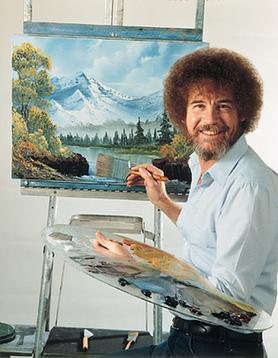
Born in Florida in 1942, Bob Ross didn't discover oil painting until he started taking art lessons whilst serving in the U.S Air Force. He studied the 'wet-on-wet' technique and became 'hooked'.
After leaving the Airforce, he continued to study at various art schools, perfecting his 'wet-on-wet' technique and even teaching it to several of his friends and colleagues.
In 1983 Bob Ross's televised lessons, 'The Joy of Painting' premiered. Where it attracted millions of viewers during the decade that it ran. The appeal of the show was not only Bob's humour and lovable persona, but also the fact that watching him complete a full painting in just 30 minutes gave people the inspiration to give it a go themselves.
The Joy of Painting TV series was so successful, it was carried by over 275 television stations. Bob Ross Inc produced videos, books and all the materials required to paint along with Bob as well as certifying instructors to teach people to paint in Bob's style. Sadly, not long after his original TV shows stopped airing, Bob passed away from Lymphoma at the age of 52.
Now, decades after his death, the Joy of Painting series can now be found on Netflix, YouTube, Amazon Prime and even the BBC making Bob Ross more watched than ever!
What is the 'Wet-on-Wet' Technique?
The wet-on-wet technique in oil painting, also known as 'alla prima' is where you apply a new layer of oil paint, on top of a still-wet layer rather than waiting for a layer to dry before applying the next. This method allows you to complete a whole painting very quickly – which is a big part of the appeal to people watching Bob's shows.
Where can I watch Bob Ross?
If you are in the UK and have a TV licence, you can visit BBC iPlayer and watch the first 2 series of The Joy of Painting.
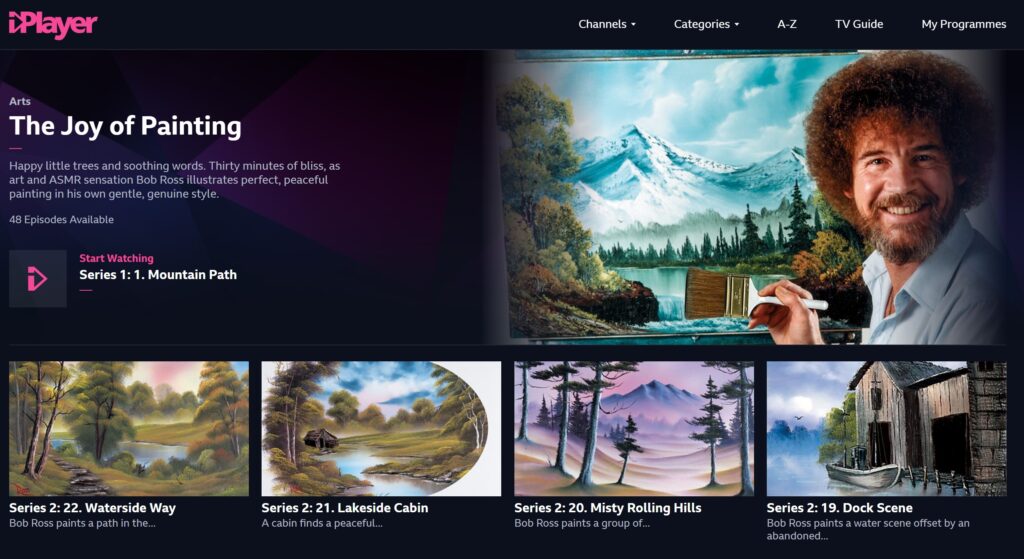
Alternatively, you can catch up on Amazon Prime video or if you are in the US – the Bob Ross YouTube channel has every episode free to watch there. Unfortunately, that content is not available in the UK.
What Materials do I need to follow Bob Ross's Technique?
You can follow Bob Ross's technique using any oil paints, we have been told by customers that our Ken Bromley Oil Paints have a similar consistency to the thicker Bob Ross oil paints. Many people also use Daler Rowney Georgian Oils, or Winsor & Newton Winton. If you want to follow Bob's technique using Water Mixable Oil Paint, this is also possible using any water mixable oils. Just make sure you make your own liquid base coat and don't use the official Bob Ross brushes which can not get into contact with water.
Bob Ross Inc. also produce a whole range of materials to Bob's original specification which you can use to follow his demonstrations.
We have listed out the main materials he uses for his Landscape series – including a useful recipe to make your own liquid base coats! We have also included a helpful video made by certified instructor Sophia Flowers where she talks us through her recommended equipment for starting out.
Base Coats
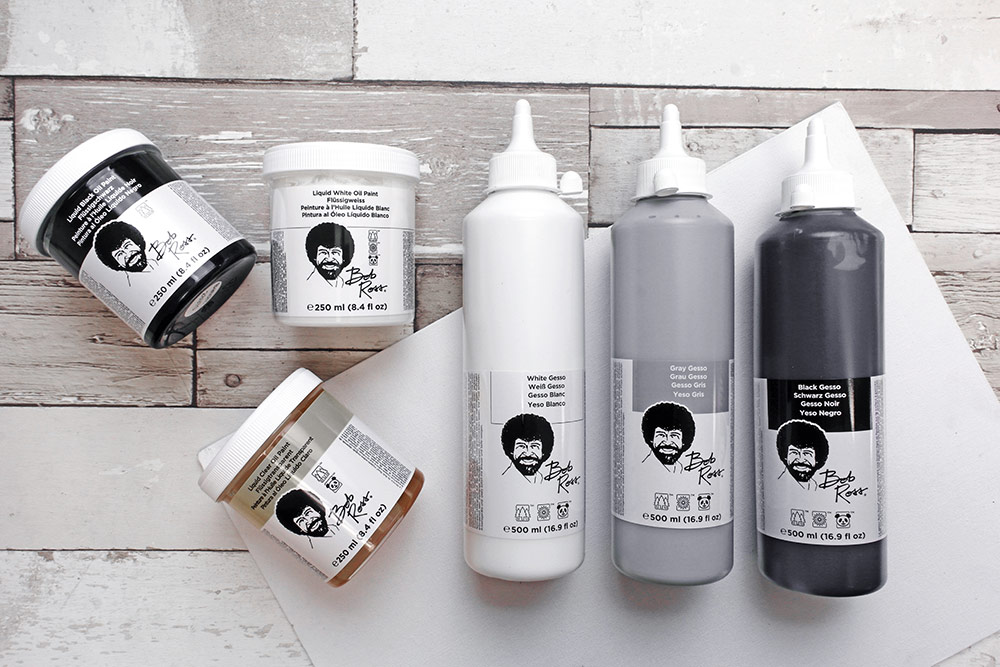
There are two types of base coats in the Bob Ross range, the liquid base coats which are essential for the wet-on-wet technique, and the gessos which you can use under the liquid clear.
Liquid Base Coat
Essential for the Bob Ross wet-on-wet technique. The first step to the painting process is to coat the canvas in a liquid base coat which allows the paint to be blended directly on the canvas rather than on the palette. It can also be used to thin other colours. Available in white, black, clear and opal. The whole idea that a thin paint will stick to a thick paint is the basis behind the whole technique.
Helpful hint ~
You can make your own Bob Ross liquid base coats. Below are recipes using Winsor & Newton products. This can be especially useful it you would like to try using the wet-on-wet technique using water mixable oils – you can make your own 'water mixable liquid white' using the Artisan recipe.
Liquid Clear——Stand Oil 4 parts to Sansodor one part.
Liquid White—– Winton or Artists Titanium White at 1 part to 4 parts of the Liquid Clear mix.
Water Mixable
Artisan Liquid Clear 4 parts Artisan stand oil to 1 part Artisan thinner.
Artisan Liquid White—1 part Artisan Titanium White with 4 parts of Liquid clear mix.
If too thin, add more white –too thick, add more thinner.
___________________________________________________________________
REMEMBER – if you are using water mixable oils you can not use the Bob Ross brushes, the Bob Ross brushes must be cleaned with odourless thinner and can not come into contact with water.
Bob Ross Gesso
The Bob Ross Gesso is available in white, black and grey and is used as a primer and undercoat for the canvas before you begin painting. You can use the black gesso under the Liquid clear to create some interesting effects.
Odourless Thinner
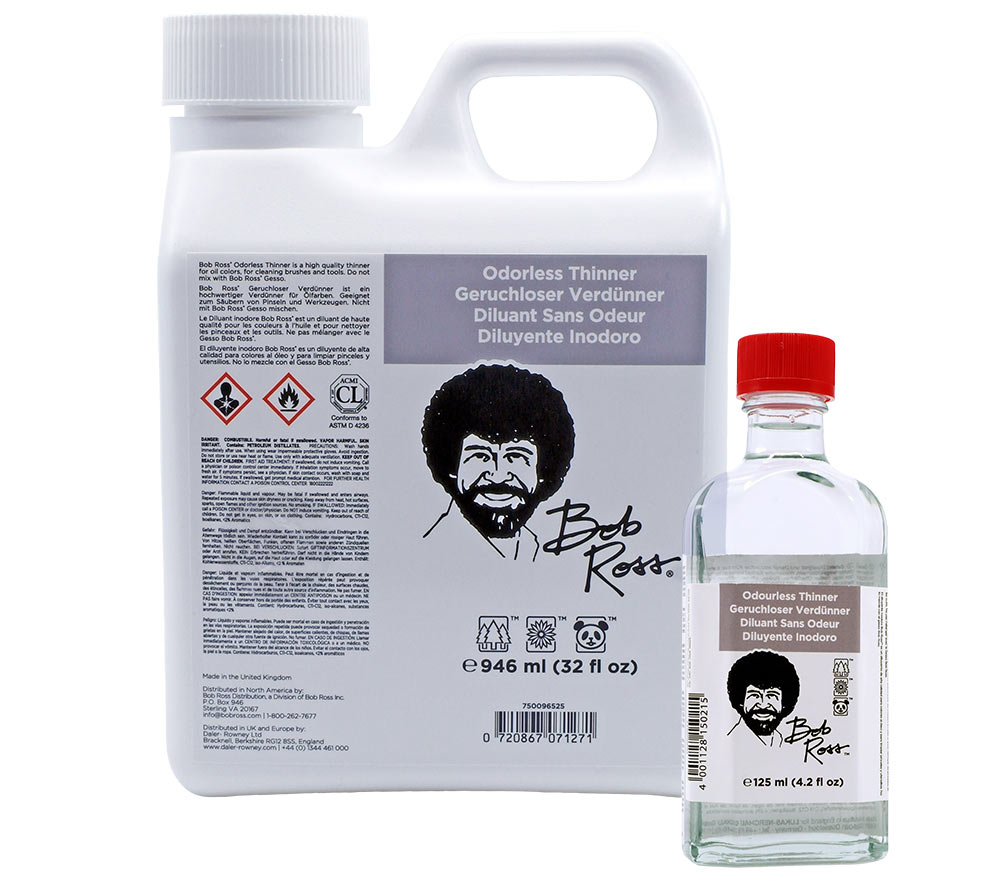
Bob Ross's odourless thinner is another essential. You can use any other type or artists' paint thinner, but this one is so popular because it is odourless. Fill a bucket with the thinner to clean your brushes. Allow the sediment to settle for a few days and it is ready to be used again!
Other odourless/low odour thinners include Loxley Low Odour White Spirit and Winsor & Newton Sansodor.
Paints
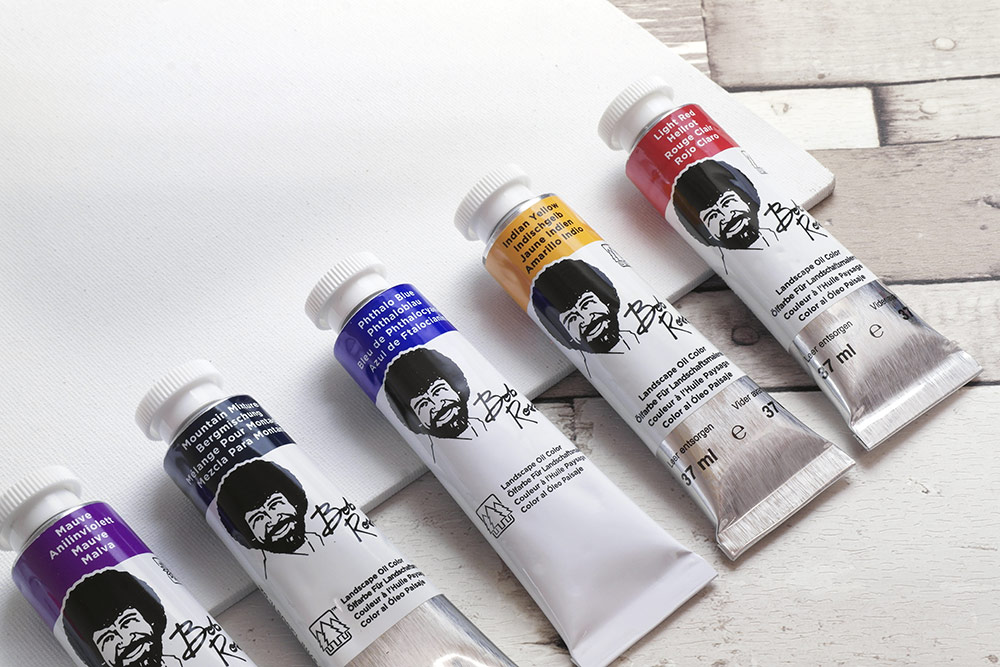
Bob Ross paints are available in two sizes, 37ml and 200ml. There are 14 colours in the Landscape range, allowing for endless natural combinations. The paint is a smooth yet firm consistency which makes it perfect for the wet-on-wet technique.
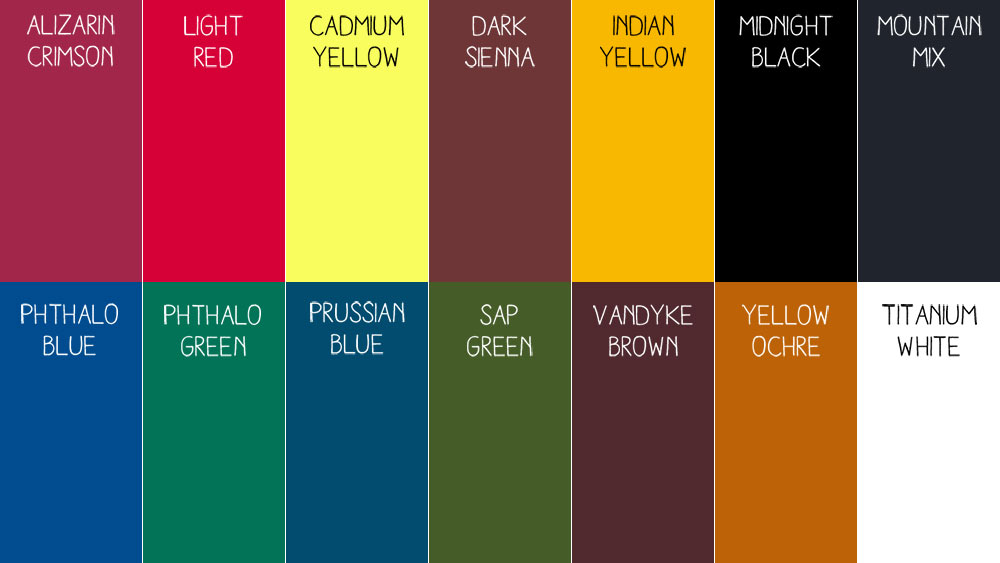
Alizarian Crimson
This is a very versatile colour in the Landscape range. Used to create purple and lavender shades when mixed and also for underpainting in dark mountain mixtures.
Light Red
This is a powerful colour and also the colour Bob used for signing all his paintings. When mixed with yellows it can be used to add highlights often found in the foreground bushes in Bob's paintings.
Cadmium Yellow
Out of the three yellows in the range, Cadmium Yellow is the brightest. Used for the brilliant sunlight in the sky as well as to highlight green areas when mixed with Sap Green.
Dark Sienna
Of the two browns in the Landscape range, this is the lighter. Mixed in a marbled mixture with Titanium white, Bob often uses it to create highlights on the cabins and the trees.
Indian Yellow
Another of the three yellows in the Landscape range, Indian yellow is often used to paint the sun in the sky. It can also be used to vary the colour of the highlights on trees, bushes and grass.
Midnight Black
Used alone as a base colour for simple shapes of the trees and bushes. It can also be mixed with the Titanium white in different ratios to create a selection of different greys.
Mountain Mixture
Not only used for mountains, as the name suggests, it is used to underpaint other objects such as trees, bushes and ground areas.
Phthalo Blue
A strong blue colour which is most often used for skies and water – but also excellent for snowy highlights.
Phthalo Green
This green is almost a fluorescent colour. Because of its transparent qualities, it can be used on top of black gesso creating beautiful effects, such as those found in Bob's Northern Lights paintings.
Prussian Blue
Darker than the Phthalo blue, it is often used in the cold winter skies in Bob's paintings. It can also be used to darken the corners of a Phthalo Blue sky to create a vignette effect.
Sap Green
The main colour used for all foliage. When mixed with the yellows and the bright red it can be used for wonderful highlights on the for all things green as well.
Titanium White
Use alone for highlights, clouds, snow or mixed with other colours to create a variety of shades.
Van Dyke Brown
This is the darker of the two browns in the Bob Ross Landscape range. Used for underpainting large trees and cabins and a 'go to' colour for all dark base coats.
Yellow Ochre
A beautiful soft hue, just right for making the highlights on foliage, it is the darkest of the three yellows in the Landscape range. Mixed with the sap green, or one of the other yellow, it can be used to add interest to the foliage.
Brushes & Knives
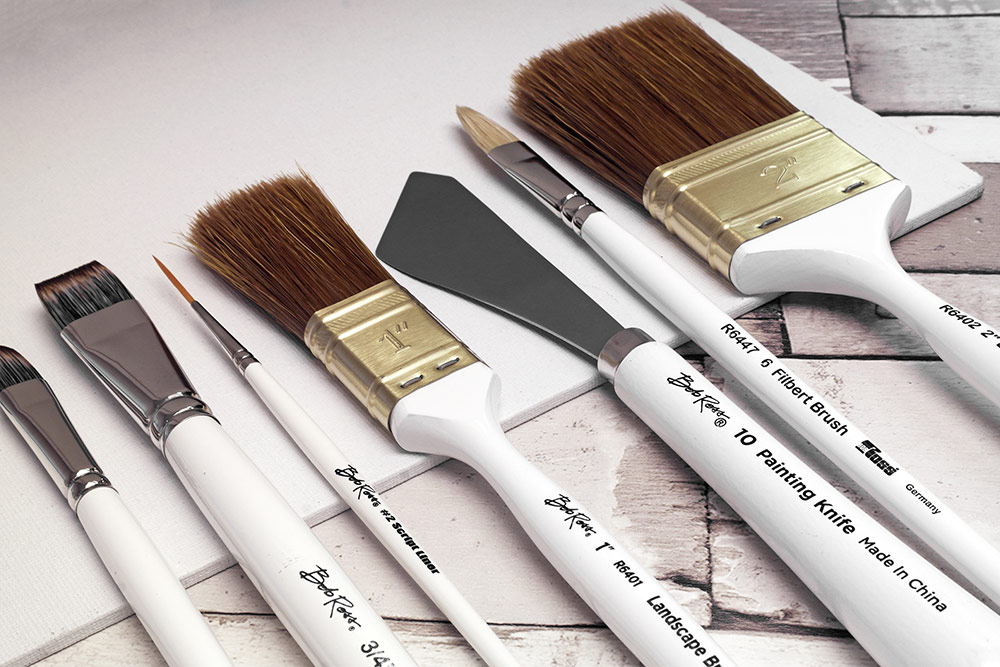
The whole range of Bob Ross Landscape brushes are made to Bob's specifications. All made from natural bristle perfect for the wet-on-wet technique. Just remember, these brushes can not be cleaned with water, you must always use a solvent such as the Bob Ross Odourless Thinner.
Whilst there are no direct replacements for some of the Bob Ross brushes, we do have a selection of alternative oil painting brushes on our website which would be suitable for painting in Bob's style. If you are using water mixable oils, it is advisable to go for a synthetic hair.
1" Landscape Brush
One of the four large brushes in the Landscape range and probably the most commonly used. Used in the application of the liquid base coat as well as for painting skies, clouds, water, mountains and many other elements of Bob's iconic landscapes.

2" Background Brush
Can do all the same things as the 1" brush, but it's larger size allows you to do all of the above at a much faster speed!

1" Round Foliage Brush
Another one of the four large brushes in the range, this brush is not just for foliage, but also great for clouds, trees, bushes and foothills.

2" Soft Blender Brush
This blender brush allows you to create the soft delicate areas in the landscape and seascapes. Wispy clouds in the sky, mist at the base of mountains, the crest of a wave and spray from waterfalls.
Half Size Round Brush
This brush is perfect for creating wonderful shapes for trees, bushes and other foliage.
1" Oval Brush
The 1" Oval is primarily used for evergreen trees and highlights.

#3 and #6 Fan Blender Brushes
Two different sizes used to create a plethora of things. Grass, hills, clouds, mountains, boats and many other beautiful effects. The #3 does just the same as the #6, but just smaller!

#2 Script Liner Brush
Perfect for details, fine grasses etc this is a special brush made from natural bristles.

#6 Bristle Filbert Brush
Used a lot for Bob's seascapes, as well as for tree trunks and other small details.

Painting Knives #5 and #10
These straight edged knives are unique to Bob Ross and are larger and firmer than other painting knives.
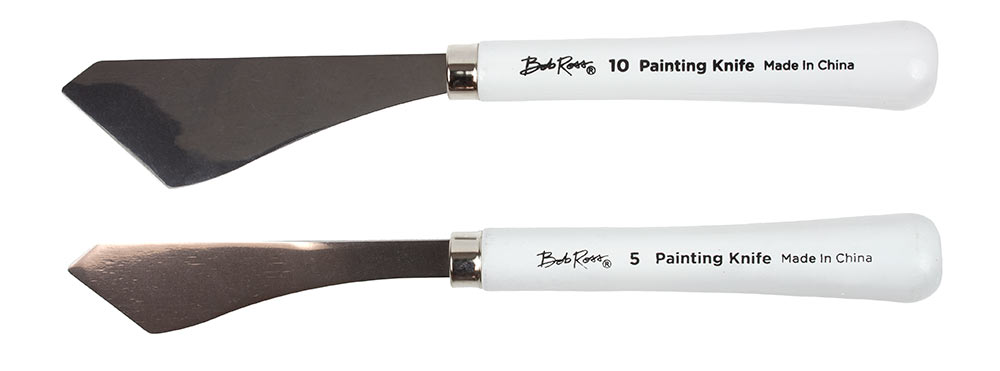
Sophia Flowers Introduction to Bob Ross Materials
Watch the video below to see certified instructor Sophia Flowers take us through her recommended basic set up for getting started with Bob Ross materials.
Visit our website to find the full selection of Bob Ross materials and get started on your Bob Ross painting!
What happened to All Bob's Paintings?
For every episode of the Joy of Painting, Bob painted 3 versions of the artwork. One before the episode to be used as a visual reference, the one he actually completes during the show and a third to be used for his books. This means there are literally hundreds of Bob Ross Paintings in existence, but apart from a few that are now displayed in the Smithsonian National Museum of American History, the rest are simply in storage. See the short film below to see the story of Bob's paintings.
Sources:
- https://www.biography.com/artist/bob-ross
- https://www.bobross.com/
- https://www.britannica.com/biography/Bob-Ross
- https://www.nytimes.com/2019/07/12/arts/bob-ross-paintings-mystery.html
Bob Ross Painting Classes in Silt Colorado
Source: https://www.artsupplies.co.uk/blog/bob-ross-materials-the-joy-of-painting-wet-on-wet/
0 Response to "Bob Ross Painting Classes in Silt Colorado"
Post a Comment